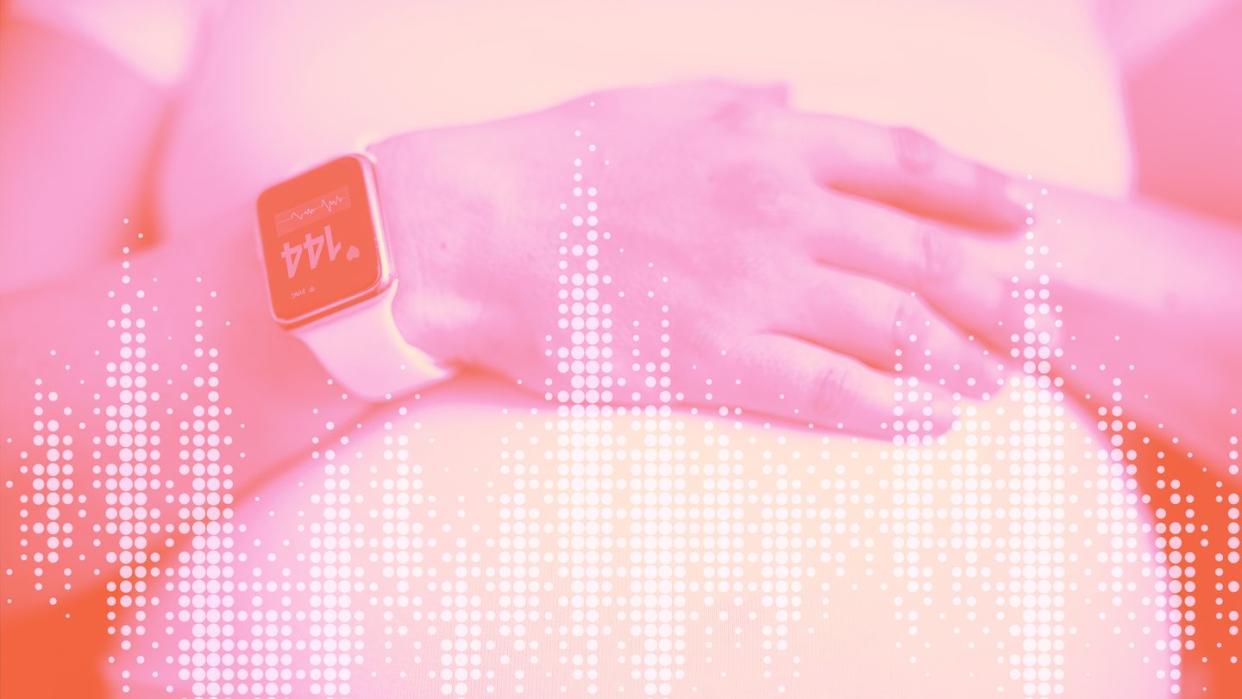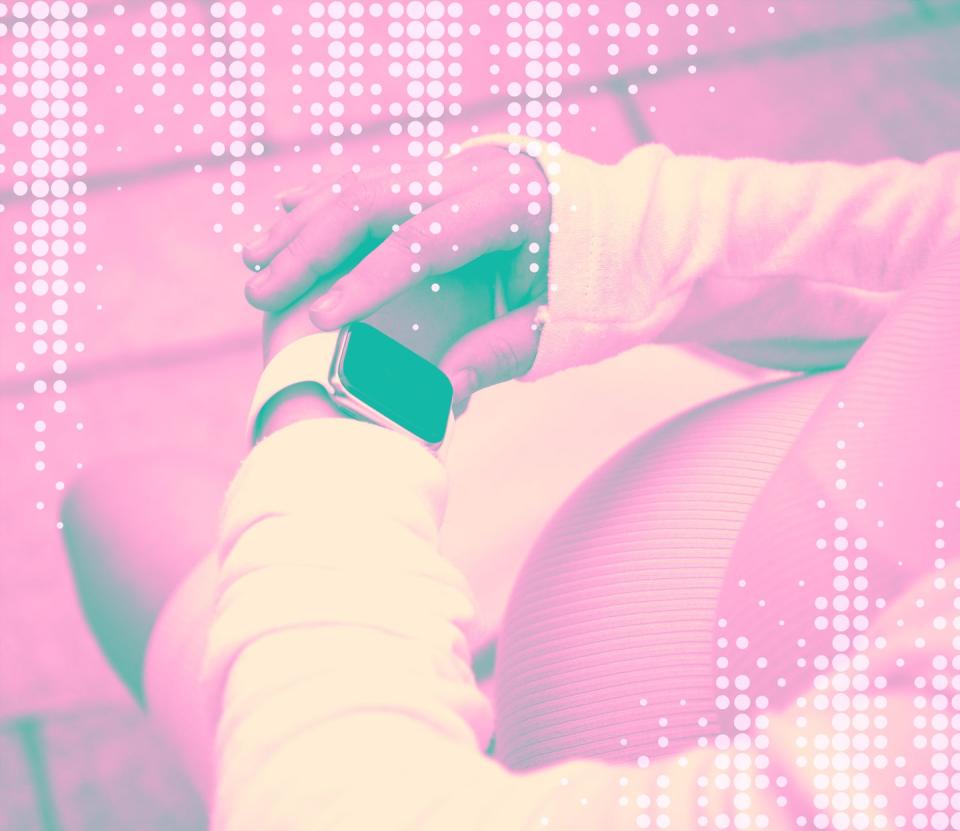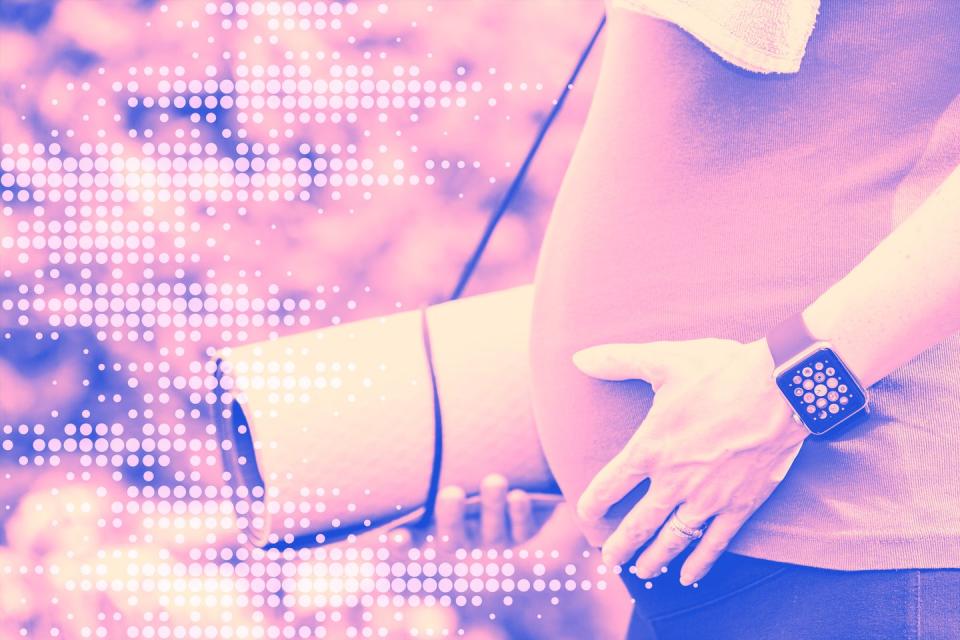An Apple Watch Saved This Pregnant Woman’s Life. How Many More Could It Help?

"Hearst Magazines and Yahoo may earn commission or revenue on some items through these links."
After a busy morning rushing from patient to patient in the pediatric cardiology clinic where she worked, Rachel Manalo, DO, was looking forward to her lunch break. It was a cherished few minutes for her to sit down and take a breath. And at 18 weeks pregnant, she especially relished that moment of quiet. But that day, her body just wouldn’t—or couldn’t—relax.
“My heart was beating super fast, even when I was resting and paying attention to my body,” Dr. Manalo says. “I use my Apple Watch to track my heart rate during exercise, so I immediately went to the ECG feature and turned it on.”
Her heart rate was around 150 beats per minute—much higher than her resting heart rate during pregnancy of roughly 80 bpm, and closer to what she’d expect to log during a workout.
As a cardiologist, Dr. Manalo knew this was unusual. But she also knew pregnancy can cause a lot of weird physical and biological changes. Shortly after, her heartbeat had slowed again. She asked a colleague to look at the Apple Watch data but didn’t mention the incident to her ob-gyn. “The electrophysiologist I work with said to just continue monitoring it for now, because it only happened that one time,” Dr. Manalo says. “I didn’t want to worry my OB.”
But as her pregnancy progressed, the episodes kept recurring. Every time she felt her heart begin to race, she recorded it on her watch. At 33 weeks, she often felt dizzy and out of breath. One night after work, her heart raced for hours. “It would race for a minute, then calm down, then race again,” she says. “I could see the pattern forming on my watch.”
Dr. Manalo made an appointment with a cardiologist who, using hospital instruments, made a diagnosis that aligned with Dr. Manalo’s Apple Watch data: ventricular tachycardia (VT), an abnormal heart rhythm that occurs when the lower chambers of the heart beats too quickly.
VT can result from a structural issue in the heart at birth, or it can arise when heart cells spontaneously start producing an electrical impulse they’re not supposed to. It is also a rare but known complication of pregnancy. If a fast VT heart rhythm goes on too long, it can impact the heart’s ability to pump blood and oxygen to the rest of the body. Sustained VT (i.e., an episode lasting longer than 30 seconds or requiring intervention within 30 seconds due to insufficient blood flow) can also lead to cardiac arrest.
Hoping rest and a new prescription medication would help, Dr. Manalo started maternity leave early. But a week later, the abnormal rhythm returned. “[My heart] raced for a full hour with no stopping. I had to go to the ER,” she says.
Once again, she used her watch to capture what was happening. When she got to the hospital, the doctors were able to act quickly. After they tried different medications to bring her heart rate to normal, her blood pressure started to drop (a sign that her life and her baby’s life were in danger), and they ordered an emergency C-section. Her baby girl was born the next morning.
“I could have developed cardiomyopathy [a disease in which the heart muscle can’t pump blood effectively] or potentially died if I had not been able to closely monitor my heart rhythm during my symptoms,” Dr. Manalo says. “The watch helped me tell that my palpitations weren’t just anxiety but truly abnormal.”
Dr. Manalo isn’t the only pregnant woman whose wearable health tracker may have helped save her life. In December 2022, a pregnant woman in Costa Mesa, California, was wearing an Apple Watch when it warned her of a racing heartbeat that turned out to be the first signs of placental abruption, a rare pregnancy complication. In 2021, a pregnant Kentucky mom’s Apple Watch alerted her to an abnormal heart rhythm that turned out to be a rare heart infection called myocarditis.
Other companies that produce wearable health trackers such as the Oura Ring, Garmin watches, and Whoop are also dialing into technological solutions to help women track biological data (and especially heart rates) during pregnancy.

A Revolution In Pregnancy Tracking Tech
From watches and smart rings to health-tracking apps, Bluetooth-enabled blood pressure cuffs, and continuous glucose monitors that help with gestational diabetes, new tech products are becoming a key tool for managing preconception, pregnancy, and postpartum health. And experts have started paying attention to the data these tools collect.
Sometimes it’s the small physical and biological changes that might otherwise go undetected that affect a pregnant woman and her baby’s health. For example, changes in sleep and activity could be used to predict preterm birth, one 2023 study found. Other small studies suggest that trackers can encourage physical activity and weight management in pregnant women, two factors that can reduce pregnancy complications. Another paper found that pregnant women wearing a FitBit tracker increased their daily step count by 1,716 steps on average.
“Trackers can be immensely powerful tools to help us, in real time, take what we know about our environments, our sleep habits, our eating, our movement, and show how those inputs affect internal metrics, heart rate, blood glucose levels, and sleep metrics,” says Christy Evans, MD, an ob-gyn at Almond Obgyn. “These tools are as powerful, if not more so, in pregnancy, when women may feel like the stakes are even higher.”
Recently, ob-gyns have noticed more patients, like Dr. Manalo, using health trackers to monitor their heart during pregnancy and postpartum. It’s a promising trend, considering the latest numbers show that maternal mortality rates in the United States remain higher than in other industrialized countries. In 2022, roughly 22.3 women died per 100,000 live births, an increase from 17.4 deaths per 100,000 live births in 2018, per the Centers for Disease Control and Prevention. The trend is even worse for Black women, whose maternal mortality rate is nearly three times that of white women.
Right now, cardiovascular disease is the number one cause of maternal mortality in America, according to Jenny Y. Mei, MD, the ob-gyn at UCLA Health who treated Dr. Manalo after she arrived at the ER. “So, especially for patients who are at higher risk, technology could help address that component.”
Dr. Mei coauthored a case study on Dr. Manalo’s story that highlighted the need for larger-scale research on the topic. She is also involved in research looking at how remote blood pressure monitoring (in which patients upload their own blood pressure readings from an arm cuff into an app from home) can improve outcomes. “The ability to upload readings allows health-care providers to monitor blood pressure efficiently and more often. It’s having an impact in reducing ER visits, which are a proxy for tracking complications,” Dr. Mei explains.
This type of remote blood pressure monitoring may even help reduce racial disparities in maternal health. A 2023 paper found that Black patients were less likely to discover their high blood pressure if they were in the group that only checked blood pressure in-office (so more likely to detect their high blood pressure in remote monitoring), and another paper found that Black women and other high-risk groups in a remote blood pressure monitoring program received medication adjustments that reduced ER visits.

Preventive Care You Can Wear
Some doctors think wearable health-tracking technology will be especially important as more women delay pregnancy past age 35 (when the risk of complications is greater) or start pregnancy with chronic conditions such as diabetes or high blood pressure.
Amanda Horn, a nurse midwife at Holston Medical Group in Kingsport, Tennessee, says the vast majority of her patient population has an underlying disease, meaning there is greater risk for potential complications during pregnancy and postpartum. “Depending on your health status, you may need to be more vigilant, so I can see where more data and monitoring could potentially play a role,” she says.
Although doctor visits become more frequent during pregnancy, for women at high risk for complications, it may not always be enough to adequately monitor what’s happening in their body. “The traditional prenatal care model means prenatal visits every four weeks for the first and second trimesters and every two weeks through most of the third trimester. That adds up to just 12 to 14 vital sign measurements,” says Santosh Pandipati, MD, a maternal-fetal medicine specialist at Pediatrix Medical Group in Campbell, California. “There is a vast amount of missed data opportunity across the entire pregnancy and postpartum journey. More data means more ability to obtain crucial insights, which in turn means more opportunity for early intervention.”
Additionally, a dearth of high-risk-pregnancy specialists in many parts of the country highlights other ways wearable health trackers could benefit women. “A lot of people are relying on virtual visits, and this type of remote monitoring could help patients who otherwise can’t do this kind of care in person,” says Dr. Mei. That might mean wearing a tracker (like a watch) that can monitor heart rate or using a Bluetooth-enabled blood pressure cuff or continuous glucose monitor that can upload results directly to your doctor. That way, they can alert you to potential problems, provide advice, or direct you to the ER or other in-person care as needed.
However, while these tools may be helpful for connecting the dots, doctors emphasize there is no replacement for being evaluated by a professional. “Whether or not you have a watch, when you have heart palpitations or otherwise don’t feel well, it’s important to bring it up with your doctor,” says Christine Greves, MD, an ob-gyn at Orlando Health Winnie Palmer Hospital for Women & Babies.
And of course it will take more than a few Apple Watches to solve the maternal health crisis, which is compounded by socioeconomic factors like low income, housing and food insecurity, and substance use disorders. A larger overhaul of the maternal health system (including increasing access to health care via free or low-cost care and more housing support and other services for pregnant women and moms) is needed to truly move the needle.
More Info Isn’t Always The Answer
There are other potential downsides to relying on wearables for health information. For starters, more info isn’t necessarily better. Heart palpitations are expected during pregnancy and, in most cases, very normal, says Horn. “I’ve had folks come to me with heart rate increases, and we end up doing significant interventions with seven-day monitors just to discover it is in fact benign. So, it can be a blessing and a curse. It can also mean we’re doing more intervention than we needed to do.”
Conversely, Dr. Greves worries that patients will consider their watch’s assessment the be-all and end-all, and they could miss important clues because they’re busy thinking, Well, my watch says I’m fine.
At the end of the day, you have to understand the limits of the data to use it most effectively. Doctors suggest leaning on tech to collect data…and nothing more. “It’s a helpful adjunct that can help detect a trend,” Dr. Greves says. “At the same time, your body will send you signals if something is off. In a way, you have an internal ‘watch’ already.”
More research is needed to determine best practices when it comes to technology during pregnancy. It could be that only people with certain health risks such as obesity, known cardiovascular or metabolic disease, or being 35 or older during a first pregnancy stand to benefit. Still, experts say being aware of symptoms and reporting concerns to your provider is always a good move.
No one knows that better than Dr. Manalo, who underwent a procedure called an ablation to correct her VT two months after giving birth. Thanks to that early intervention and procedure, she’s now back at work and chasing after a healthy toddler at home. And to this day, she credits her Apple Watch with helping to save her life.
You Might Also Like

